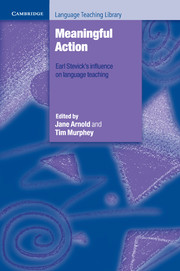Book contents
- Frontmatter
- Contents
- List of contributors
- Acknowledgements
- Preface
- Introduction
- Part A Meaning-making inside and between the people in the classroom
- Part B Meaningful classroom activity
- Part C Frameworks for meaningful language learning
- Epilogue: A way with words – perspectives on the contributions and influence of Earl W. Stevick
- Appendix: Words of tribute to Earl Stevick
- Index
6 - Understanding language learner narratives
Published online by Cambridge University Press: 15 November 2023
- Frontmatter
- Contents
- List of contributors
- Acknowledgements
- Preface
- Introduction
- Part A Meaning-making inside and between the people in the classroom
- Part B Meaningful classroom activity
- Part C Frameworks for meaningful language learning
- Epilogue: A way with words – perspectives on the contributions and influence of Earl W. Stevick
- Appendix: Words of tribute to Earl Stevick
- Index
Summary
We are always telling stories; our lives are surrounded by our stories and those of other people. We see everything that happens to us in terms of these stories, as we sometimes try to lead our lives as if we were recounting them.
(Jean-Paul Sartre, Les Mots)Introduction
In this chapter I explore language learner narratives in four ways. Specifically, I explain the context of general narrative research and the relationship between narrative and story, identify general types of language learner narratives, note important themes in existing learner narratives and highlight useful ways to interpret new learner narratives. These interpretive tools are using empathy, accepting subjectivity, seeking emergent themes through grounded theory, noticing triple re-storying, interpreting aesthetically, treating the narrative as a case, expecting complexity, looking for influences, drawing trajectories, and checking and evaluating the narrative.
The general context of narrative research
Narrative is pervasive. ‘We dream in narrative, daydream in narrative, remember, anticipate, hope, despair, plan, revise, criticize, gossip, learn, hate and love by narrative’ (Hardy 1968: 5). Life itself can be viewed as a narrative containing many smaller narratives (Moen 2006). People without narratives do not exist, according to Polkinghorne (1988). Narrative and story are often used as synonyms, and their etymologies reveal that these terms have a double meaning of telling and knowing (Harper 2010). Because narrative is ‘the primary scheme by which human existence is rendered meaningful’ (Polkinghorne 1988: 1), we interpretively construct and organize our own social realities and personal theories by selecting which details to notice, remember and emphasize (Ochs 1997; Bruner 1998). Participation in narrative practices – telling and responding to stories – can create identities and bring coherence and healing to lives (Mehl-Madrona 2010). Narrative inquiry is ‘an ethnographic approach to eliciting understandings’ (Pavlenko 2002: 213) through stories.
I gratefully dedicate this chapter to Earl Stevick, whose example and works inspired me and others to cross borders and to study deeply the narratives of language learners. Stevick's humanistic, caring and creative orientation is captured in his books, Teaching Languages: A Way and Ways (1981), Success with Foreign Languages: Seven Who Achieved It and What Worked for Them (1989), Memory, Meaning and Method: A View of Language Teaching (1996) and Working with Teaching Methods: What's at Stake?
- Type
- Chapter
- Information
- Meaningful ActionEarl Stevick's Influence on Language Teaching, pp. 95 - 110Publisher: Cambridge University PressPrint publication year: 2013



